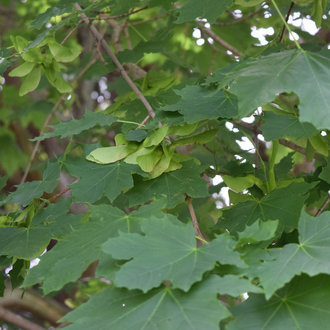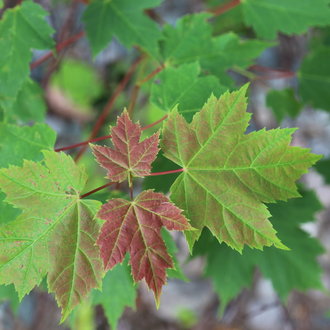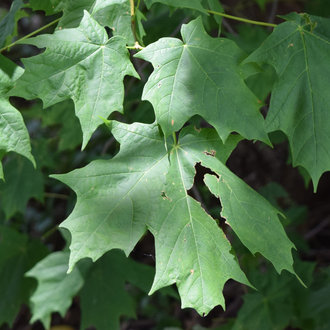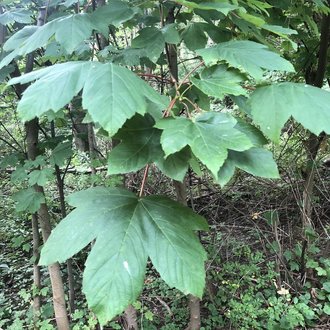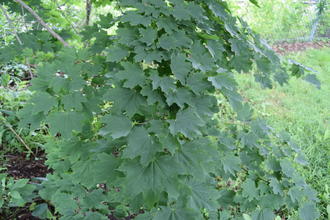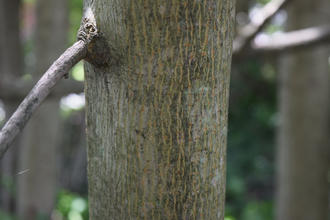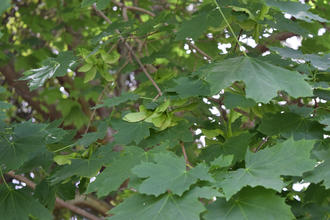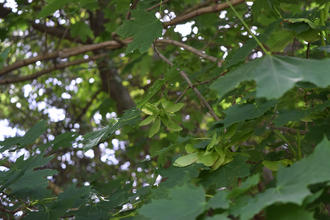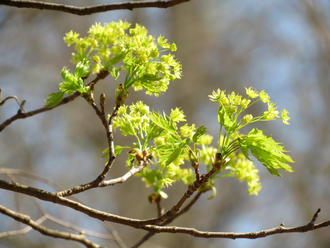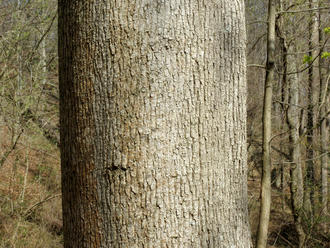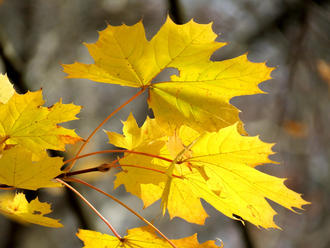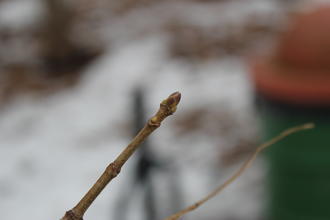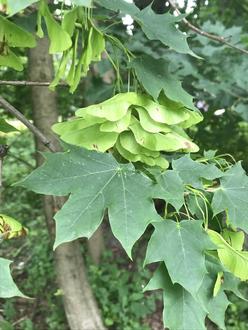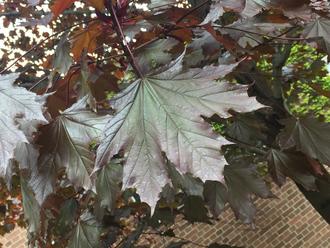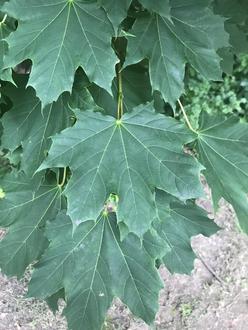Norway Maple (Acer platanoides L.)
↑Summary
A shade-tolerant tree native to Europe and Western Asia. Widely used as a landscape plant, and has become invasive in North America in the mid-Atlantic, Midwest, and Pacific Northwest.
↑Similar Plants
↑Habitat
In its native habitat, Norway maple is primarily found in lowland areas and low uplands, and also grows in mixed deciduous/coniferous forest. The habitat requirements of this species in North America are not well understood.
This tree is very shade tolerant, more so than all but a few deciduous trees in North America, but it can also tolerate high light conditions, even full sun, with sufficient moisture. It prefers deep and well-drained soils, high nitrogen availability, and mesic conditions. It is rare on acidic soils, and has more stunted growth on sandy soils. It response to fire is not well-known.
Found in a variety of different deciduous woodlands, and some mixed deciduous-coniferous woodland; its range and prevalence may be expanding. Most often found in small woodland fragments in suburbs and cities, near where it is planted, but has also invaded natural woodlands.
This species may be less adapted to North America's unpredictable climate than the more predictable, moderate climate of Europe. Although its absolute tolerance of cold is high, it can be damaged by early severe cold in autumn.
Habitat preferences overlap with those of the native Sugar Maple (Acer saccharum), and the two species can be found growing together, but Norway maple is more tolerant of urban conditions, including slightly drier and nutrient-poor conditions, pollution, and disturbance.
↑Life Cycle
Seeds germinate in spring on the surface of the ground and spread their cotyledons; true leaves are grown around 3 weeks after germination.
Seedlings are vulnerable to temperature extremes; sufficient cold can kill the young leaves, although the cotyledons are slightly more cold-tolerant than leaves. Snow may protect seedlings from cold damage.
Seedlings are highly shade-tolerant and will grow even in low light conditions. Seedlings in shade grow slowly and persist for years, until taking advantage of a gap.
Age of first seed production is variable; seeds may be produced as young as 10 years but this may be much later in shade-suppressed trees. Seed production tends to peak between 20 and 60 years of age. Some seeds are produced every year, but bumper crops may occur at 2-3 year intervals. Flowering occurs in the spring, around when the tree is leafing out, and flowers are insect-pollinated. The seeds mature slowly and are not distributed until fall; they are enclosed in a samara and are wind-dispersed. The samara is wider and flatter than most other maples.
Germination is enhanced by soil disturbance, and inhibited somewhat by deep litter, but contact with mineral soil is not required.
In their native range, trees typically live to an age of about 150 years, possibly as long as 250; max lifespan in the wild in North America is not well-known but may be dramatically shorter.
Plants that are top-killed will resprout vigorously.
↑Faunal Associations
Although native maples (Acer sp.) support a variety of insects, and this species supports many insects in its native range, in North America it is eaten by few insects. It likely has unique defenses that make it harder for native insects specializing on maples to consume, such as the milky sap, a feature native maples lack.
The introduced Norway Maple aphid (Periphyllus lyropictus) is a specialist on this species, and it has been found in the U.S., both in the area around New York City, and in the northwest. The introduced Asian longhorn beetle (Anoplophora glabripennis) has been found eating this tree, among numerous other species; it has been widely introduced in North America but is viewed as invasive and has been intentionally eradicated from some areas.
The flowers are pollinated by both native and non-native bees, including honeybees, bumblebees, and Andrenid bees.
↑Control
As a medium-to-large tree, removal of mature Norway maples is often costly, especially in residential and urban areas where dead trees must be removed for safety reasons. The most important thing is to avoid planting this tree in the first place. In landscaping, it is best to prioritize removal of seed-bearing trees that are adjacent to wild areas or unmaintained properties where there is suitable habitat for it.
In settings where there are no safety issues with leaving dead trees in place, trees can be killed by girdling. Girdling must cut well into the cambium, the living growth layer inside a tree's inner bark, and the cut must extend around the full trunk and also be wide enough in the vertical direction that the tree cannot regrow tissue to repair the wound. Trees may resprout from the root system and occasionally these resprouts must be killed in order to ensure the tree dies, but many trees will eventually die from a single girdling.
When large trees have good form, they can be harvested for timber.
Because this species can form dense stands in forests, it sometimes makes up such a large component of the ecosystem that its removal can drastically change the surroundings. In these cases, it can be useful to remove trees gradually by pruning major branches with the intention of killing them in the long-run, while also aiding competing vegetation. It is most effective to prune branches that are shading out or competing directly with native trees, but removing some of the uppermost branches is important for eventually killing the trees and distributing light to other plants. The best time to prune trees with this intention is usually right after they have fully leafed out, as it maximizes the drain on the tree's resource reserves, and allows other plants to grow into the available space during their time of peak growth.
In many cases, when this tree forms a monoculture or is only growing together with other invasive trees, such as is common in small, degraded forest fragments, it is critically important to seed in or plant site-appropriate native trees to take its place, so that its removal does not merely result in a surge of other invasive plants.
Where this species is reproducing by seed, young trees are relatively slow-growing and seedlings are easily pulled by hand, and 1-2 year old trees are usually easily uprooted with a trowel and gloves. Saplings too large to uproot can be cut to the ground, but must be revisited to control resprouts because this species tends to resprout vigorously when top-killed, especially on young, vigorous trees. Herbicide can be injected or painted onto stumps in cases where it is not practical to follow-up to kill resprouts. On a site where the mature trees are stressed or dying, continuous removal of seedlings will eventually remove this species once the mature trees die.
If all local seed sources are eliminated and all seedlings and saplings are removed, this tree can be completely eliminated, as it does not form a seed bank.
↑Uses
Widely cultivated as a landscaping plant, although its use for this purpose is decreasing as this plant is widely considered to be invasive and damaging to wild ecosystems. Although it is easy to grow, it can be a poor choice of a landscaping plant because its aggressive surface roots can heave sidewalks and both the surface roots and slow-to-decompose foliage can make it hard to garden under.
Cultivars exist with dark purple leaves.
The wood has properties intermediate between "soft maple" (red and silver) and "hard maple" (sugar and black). It is not widely cultivated, but where it is available it tend to have a moderate price. The wood is generally workable but tends to burn when machined with high-speed tools. Common uses include veneer, pulpwood for paper, boxes, crates and pallets, turned objects, and musical instruments. Some of the famous Stradivarius violins are thought to have been made from this wood.
↑Links & External Resources
• Norway Maple | The Wood Database (About This Site)
• Norway Maple | Fire Effects Information System (FEIS) (About This Site)
• Acer platanoides (Norway Maple) | Illinois Wildflowers (About This Site)
• Acer platanoides (Norway Maple) | USDA PLANTS Database (About This Site)
• Acer platanoides | Go Botany (About This Site)
• Acer platanoides (Norway Maple) | Missouri Botanical Garden Plant Finder (About This Site)
• Norway Maple | Virginia Tech Dendrology Factsheets (About This Site)
• Acer platanoides | Biota of North America Project (BONAP) (About This Site)
• Acer platanoides | NatureServe Explorer (About This Site)
• Norway Maple | Maryland Biodiversity Project (About This Site)
• Acer platanoides L. (Norway maple) | Digital Atlas of the Virginia Flora (About This Site)



